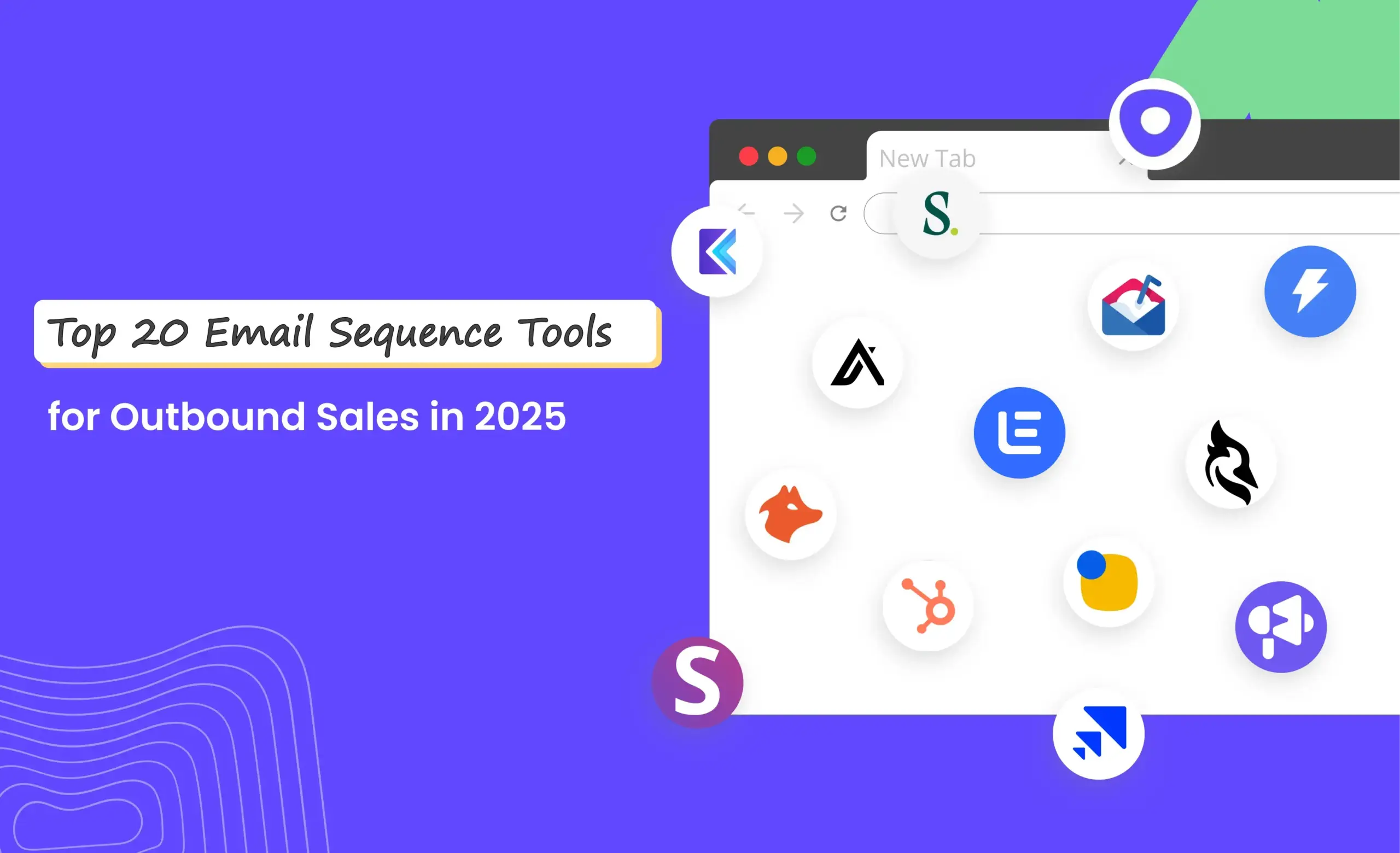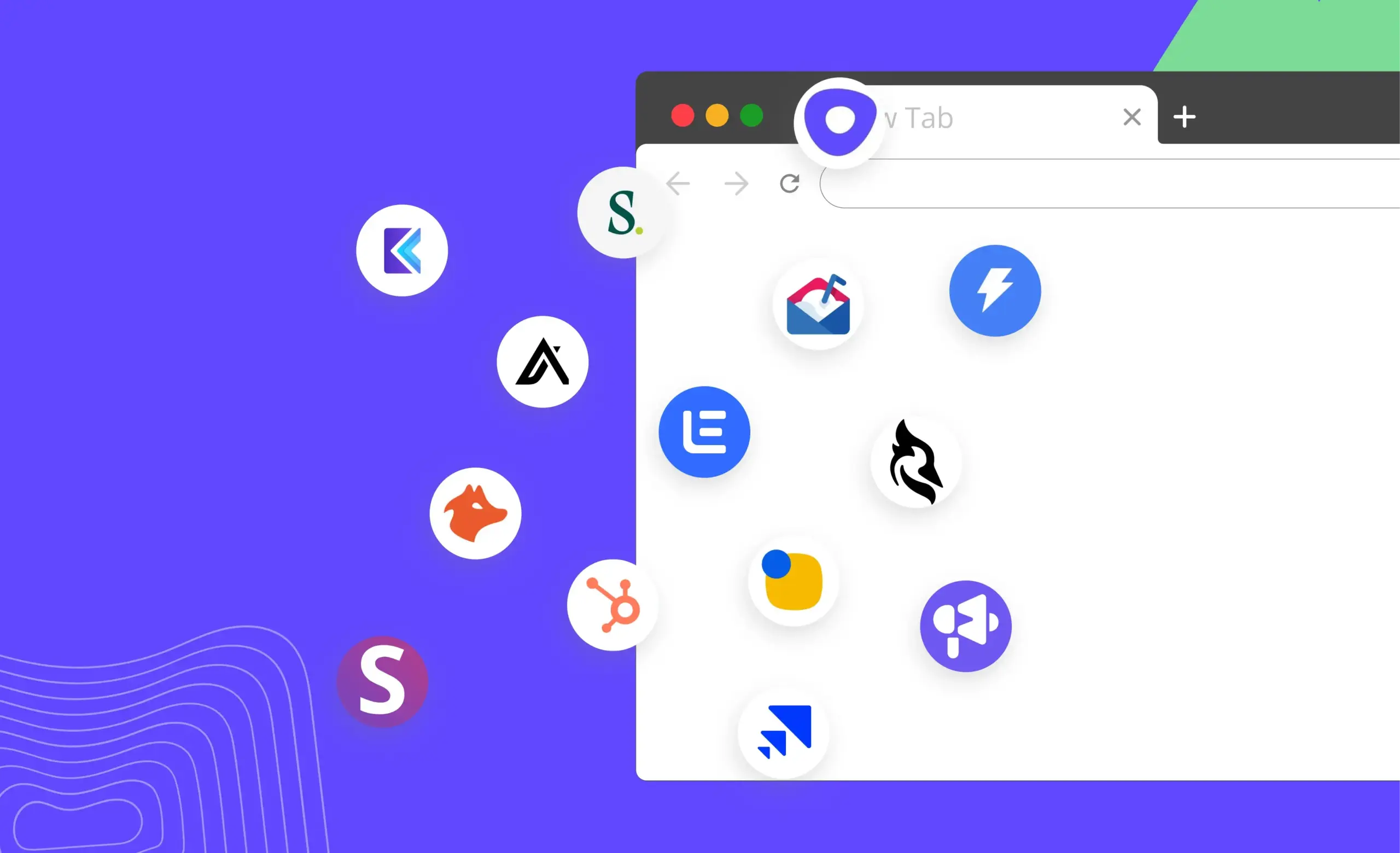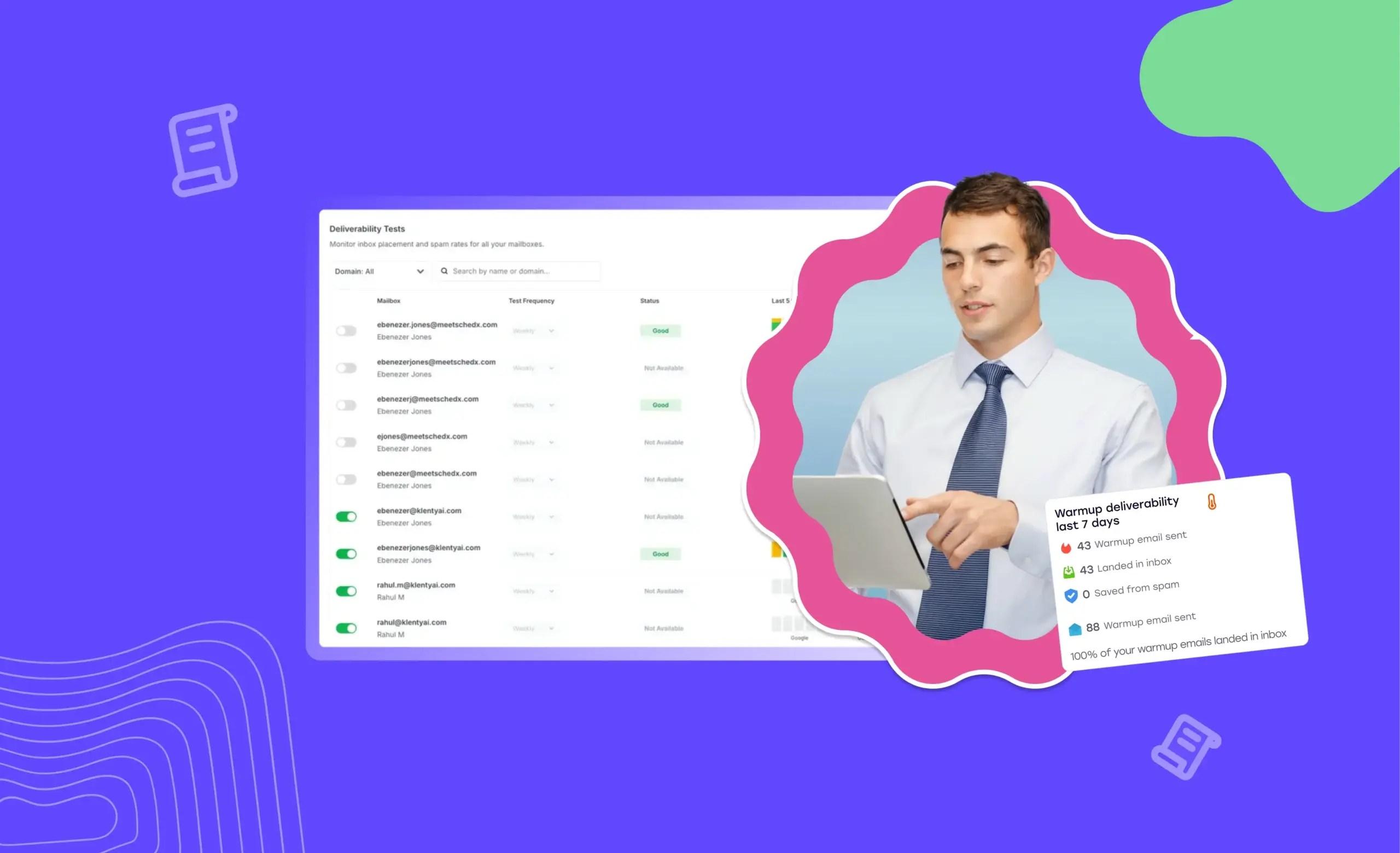Generic sales emails are deader than disco.
And sales reps are struggling to make their sales emails stand out amid a flood of emails in prospect's inbox.
They don't have a lot of time and have 100s of prospects to reach out to every day.
Enter ChatGPT, the generative AI trained to generate content according to our prompts, to the scene. Is it the holy grail that salespeople have so long been waiting for?
Will it mark the beginning of an age where salespeople can sit back and prospect while ChatGPT churns emails that hit the mark(every time)?
Well, let’s see. In this blog post, we give you 14 ChatGPT prompts you can use to craft sales emails, tips to make them better, and discuss if there’s a way to make ChatGPT work for you. (the answer might surprise you!)
6 Best ChatGPT Prompts for Sales Emails
1. ChatGPT Prompt for Pain-point Driven Sales Emails
Pain points are what keep your prospects up at night. So when you talk about their problems and a possible solution, they pay attention. Also, these emails are a great way to educate prospects about the consequences of ignoring their current pain points and push them towards your solution. Here’s a prompt we came up with:
Prompt 1: Write a sales email for {product}, which is the perfect solution to enable {benefit 1} and {benefit 2}. It offers {feature} that makes it a must-have for {target audience} and add a CTA to influence people to buy.
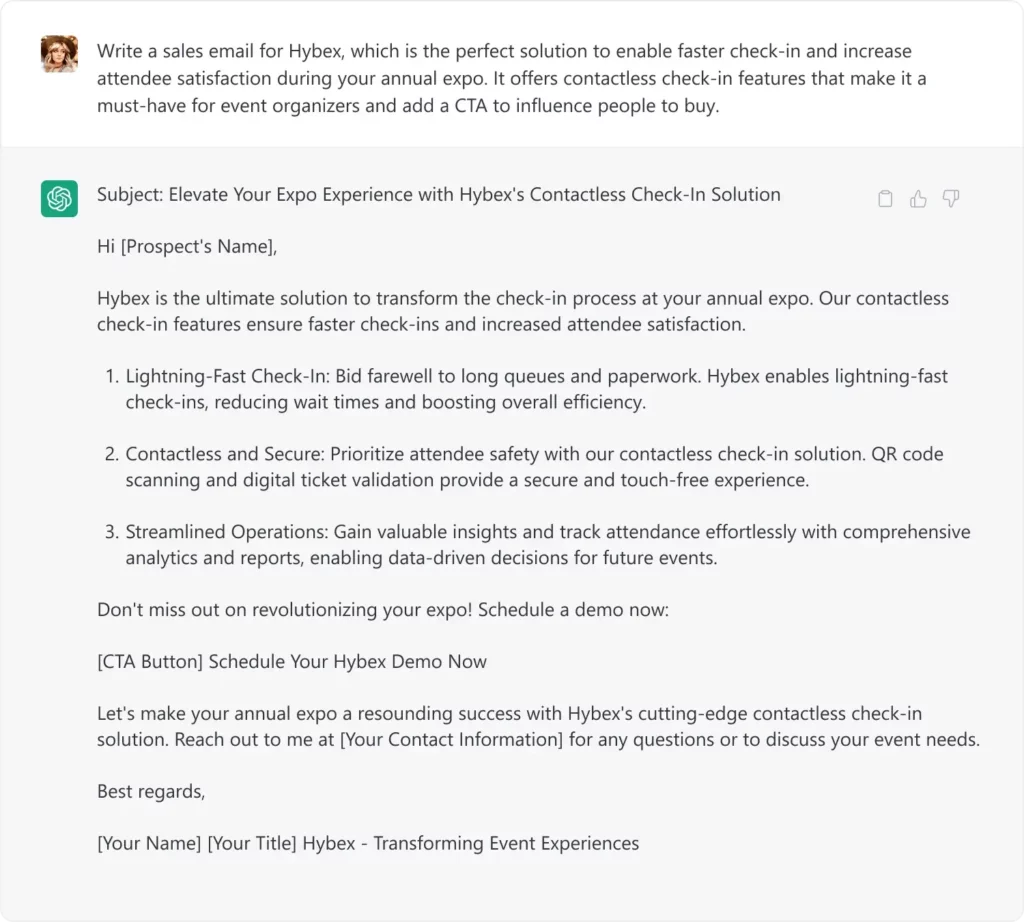
How to Make This Email Better?
- The subject line is on point as it talks about the annual expo prospect’s company has planned. You can make it shorter to optimize it for mobile phones.
Something for {Prospect’s company’s} Annual Expo
- Pitching your product right from the first line is a one-way ticket to the spam folder. Instead, start by enquiring how they plan to deal with specific event-related challenges your product can solve.
Since {prospect’s company’s} annual expo is around the corner, I can’t help but ask about your plans to deal with the long queues in front of the check-in counter.
- Avoid adding multiple CTAs to not confuse the readers. Instead, go for a soft call to action that doesn’t make the prospect feel as if they are being pinned for sale.
Worth your time {prospect}?
2. ChatGPT Prompt for Sales Emails Using LinkedIn Info
Scouring LinkedIn is the quickest and easiest way to personalize your emails. A quick look-up on LinkedIn will give you details like the prospect’s interests, recent posts, and buying intent (funding or hiring announcements).
Prompt 2: Find a conversation starter from {LinkedIn profile link} and use them to send a networking email to {prospect}. Also, at the end of the email, subtly pitch a {type of tool}, {product name}.
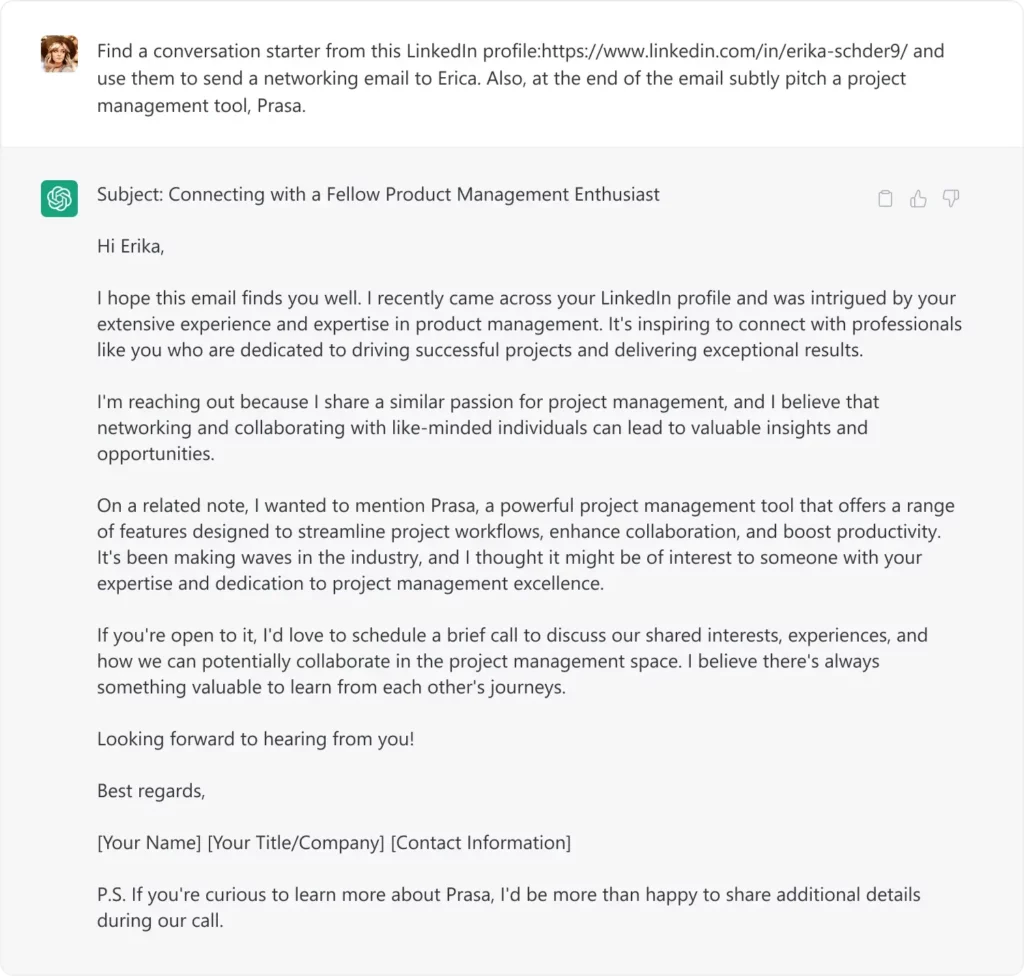
How to Make This Email Better?
- If you want to stand out in your prospect’s inbox, you should do better than this generic subject line. Mention something unique about Erika here. It can be anything, from her favorite food to her favorite project management software.
For instance, if Erica is into rock climbing, here are some subject lines you can use:
Product Management Vs. Rock Climbing
Climbing Alps and Building {their product}
- Anybody who reads this email can see through the forced (or fake) personalization here. All those statements about Erika’s project management expertise are generic statements that can be sent to any project management enthusiast. Instead, dive deep and be specific.
Read your recent post on how you increased sign-ups for {product} by 50%. Something I found especially interesting was the {approach} you followed.
- Instead of just mentioning Prasa’s been making waves in the industry, give social proof to gain their trust.
HYPP’s project managers save 30 hours every week using Prasa. {add case study link}
3. ChatGPT Prompt for Sales Emails Mentioning a Mutual Connection
Having a mutual connection with your prospective customer sets you ahead of all those salespeople trying hard to get your prospects' attention. Prospects no longer consider you a stranger and trust you enough to open up about their business problems.
Prompt 3: Write a sales email pitching your {product/service} to {target audience}. In the email, mention a mutual connection, {mutual connection name}, who asked you to reach out.
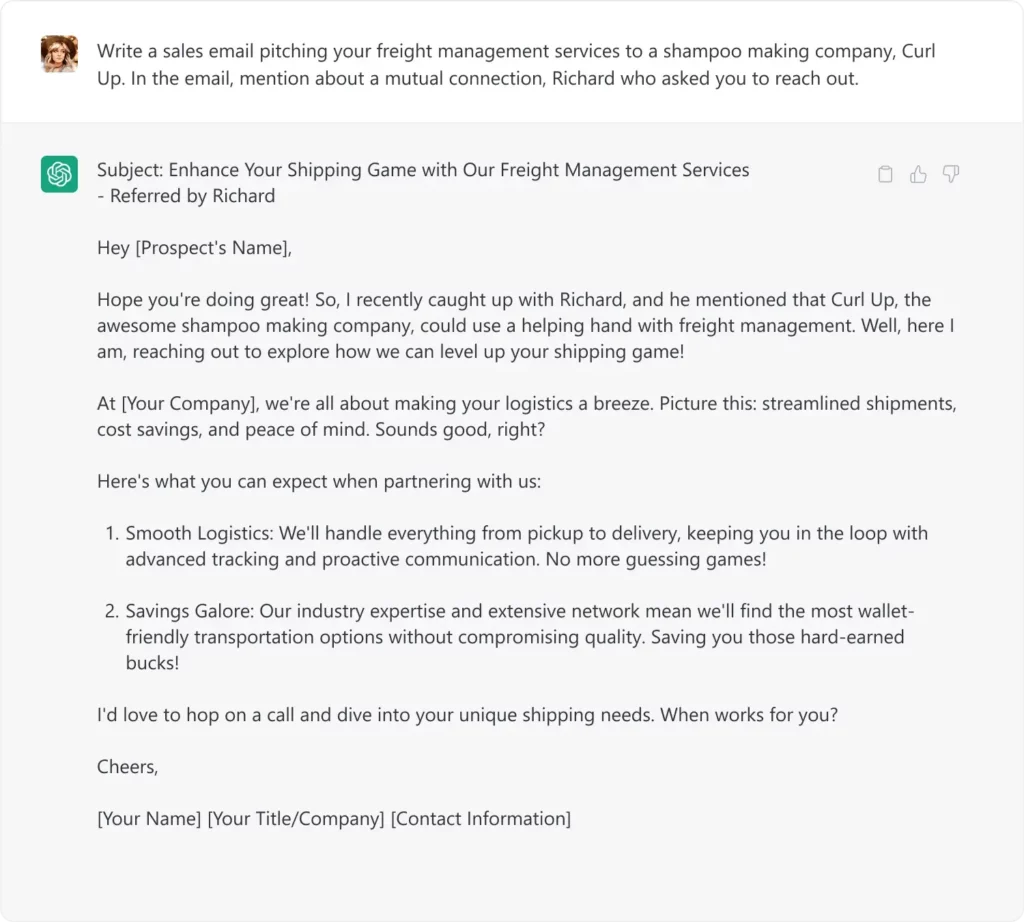
How to Make This Email Better?
- The subject line is quite long and hides the main element that might catch the prospect’s eye- the referral. So, bring that information to the front.
Richard asked me to reach out!
Richard, VP Sales, Cilori, wants us to meet!
- In the introduction, add more details about the conversation you had with your referral. Tell them where you met and how the topic was brought up. This makes the email more convincing and less pushy.
Richard asked me to reach out to you. I met him at Wefex Expo last Tuesday, and he mentioned your need for a freight management service.
- To make it more concise and conversational, do away with long sentences and make it more informal.
With {your company's} reliable transportation solutions, you gain access to cost-effective options that seamlessly manage every step, from pickup to delivery.
4. ChatGPT Prompt for Follow-up Emails
Only 2 out of 100 prospects respond to your initial sales email. That means when you don’t send follow-ups to your prospects, you are missing out on sales. But sending basic follow-ups, especially after the prospect ignores your first email, won’t make the cut. Your follow-ups should provide value and urge them to respond.
Prompt 4: How to write a concise and informal sales email follow-up after sending a quotation to a prospect who wants to scale their {process} without compromising on {something that is crucial to do task successfully} using the product {product name}, a {type of tool}?
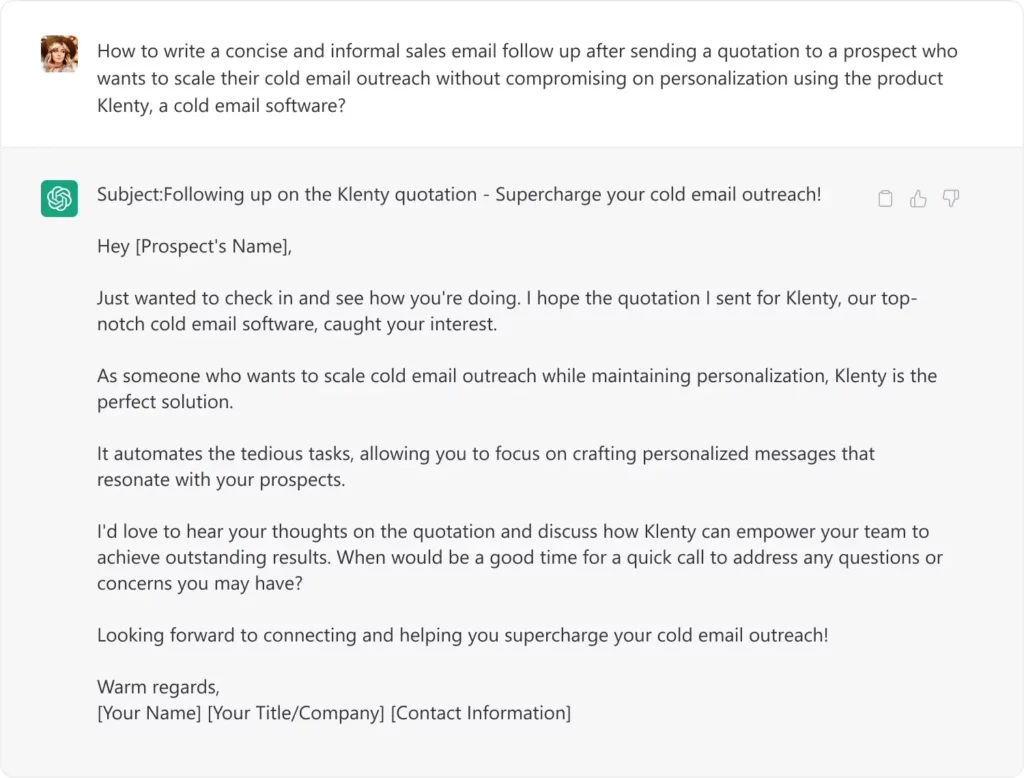
How to Make This Email Better?
- Mentioning the word ‘follow up’ in your subject line might work against you. Instead, write subject lines that focus on their pain points or the product. Here are some other subject lines you can use:
Is scaling cold outreach still a priority?
Questions about Klenty?
- Sending a quote is one of the last steps in the sales process. Thus, a quotation follow-up email isn’t the place where you go on and on about your product or value prop. Instead, include details about your demo with them, like their favorite features or aha moments.
The last time we talked, you mentioned how scaling your cold email campaigns is a major target you need to achieve by the end of this quarter. With Klenty, you can:
1. Benefit 1
2. Benefit 2
- Use a simple, one-line CTA.
Feel free to shoot your questions, I’d be happy to help.
5. ChatGPT Prompt for Personalized Cold Emails Using Prospect’s Interests
People love personalization, expect personalization, and get unhappy when you don’t personalize your messages, according to McKinsey. Personalizing your email is the key to being the red dot in a sea of white, tasteless generic emails. But to get a reply from your prospects, you should do better than using their interests to segue into your sales pitch awkwardly.
Prompt 5: Write a sales email to a {target audience} who is a {name of sports club} fan pitching a {tool} that can help him do {task}.
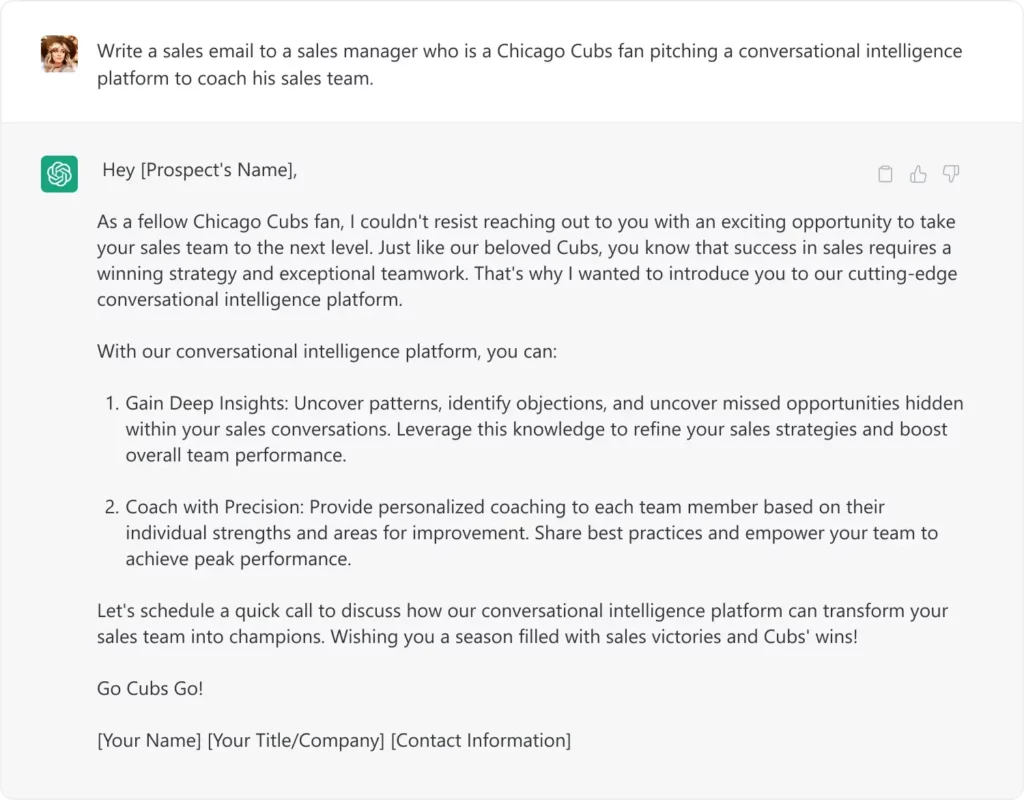
How to Make This Email Better?
- The introduction is weak and superficial. While mentioning you are a Chicago Cubs fan would grab the prospect’s eye, yoking it with your urge to pitch is the worst way to personalize it. Instead, begin your email by talking about something only a true Chicago Cubs fan can relate to.
After last night’s match, I only wish for one thing - the Chicago Cubs to come out of their losing streak. As a fellow Chicago Cubs fan, I am sure you wish the same.
- Instead of jumping straight away into your product pitch after a forced comparison, find a way to tie your product to the prospect's interest (Chicago Cubs). One possible way is to mention how training salespeople and basketball players are alike.
Sales coaching is like guiding a team on the court or in the sales arena, helping them dribble past obstacles and score big wins!
Coaching basketball players is like coaching salespeople: it's like herding hyperactive kangaroos on a basketball court or a sales jungle, making sure they don't dribble off track and always aim for slam-dunk deals!
- Use a less pushy CTA.
“Worth a chat, {prospect}?”
6. ChatGPT Prompt for Funny Sales Emails
Jokes can cause wars. It can stop wars. You can even use them to cope with wars. But would it make your prospects write a reply to your sales email? It depends. If your jokes land, you are that victorious salesperson who earned your prospect's time.
And if it doesn’t, you're just another salesperson to them. So, to stack odds in your favor, research your prospect to ensure they are receptive to your jokes.
Prompt 6: Write a funny cold email to {target audience} who are tired of {pain point 1} and {pain point 2} and are looking for a solution. The cold email should introduce your product {product name} as a solution they can use to {achieve results}.

How to Make This Email Better?
- Instead of introducing the product directly, talk about the pain points first and then mention your product as the solution they’ve been searching for.
“Sales coaching is like trying to tame a herd of wild cats while juggling flaming torches and reciting Shakespearean soliloquies.”
- Remove the filler sentences (like “Say goodbye to manual coaching and hello to productive sessions that'll make your team soar”) and replace them with punchier ones that would paint a clear picture in prospects' minds.
“HYPEAI helps your reps identify where they fall flat on their face by analyzing their talk-listen ratio, topic duration, and much more.”
- Instead of asking for a demo, ask them if they are interested in knowing more.
“Is this worth exploring, {prospect name}?”
8 Ways To Use ChatGPT For Sales Email Research
1. Best ChatGPT Prompts to Do Customer Research
Prompt 7: What are some of the major challenges faced by {target audience} who are still doing {task} manually?
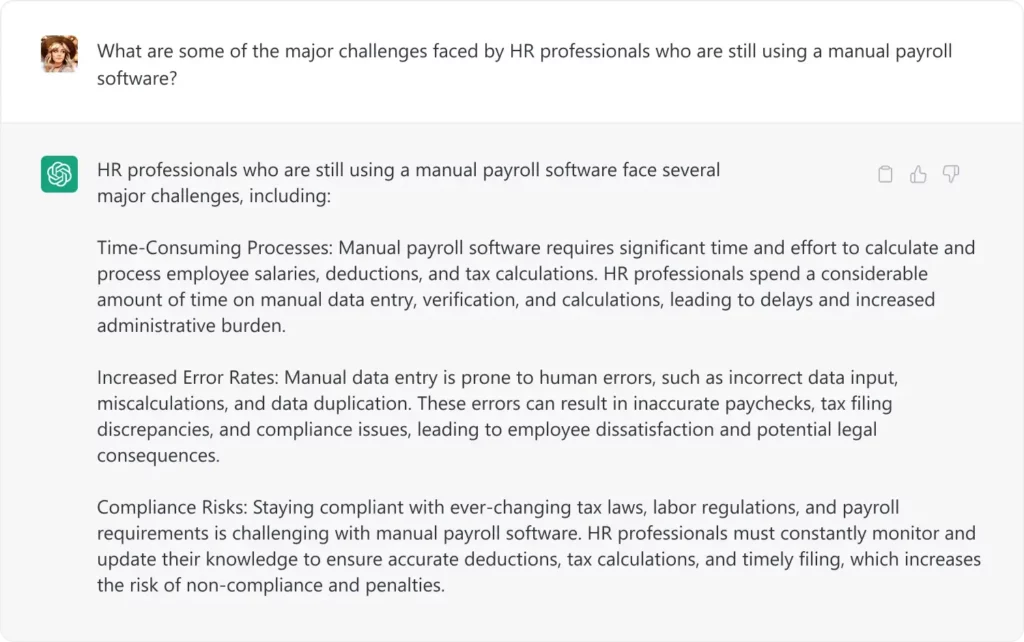
Prompt 8: What are the 3 major reasons why {target audience} hesitate to invest in a {tool/software}? What’s the best way to convince them?
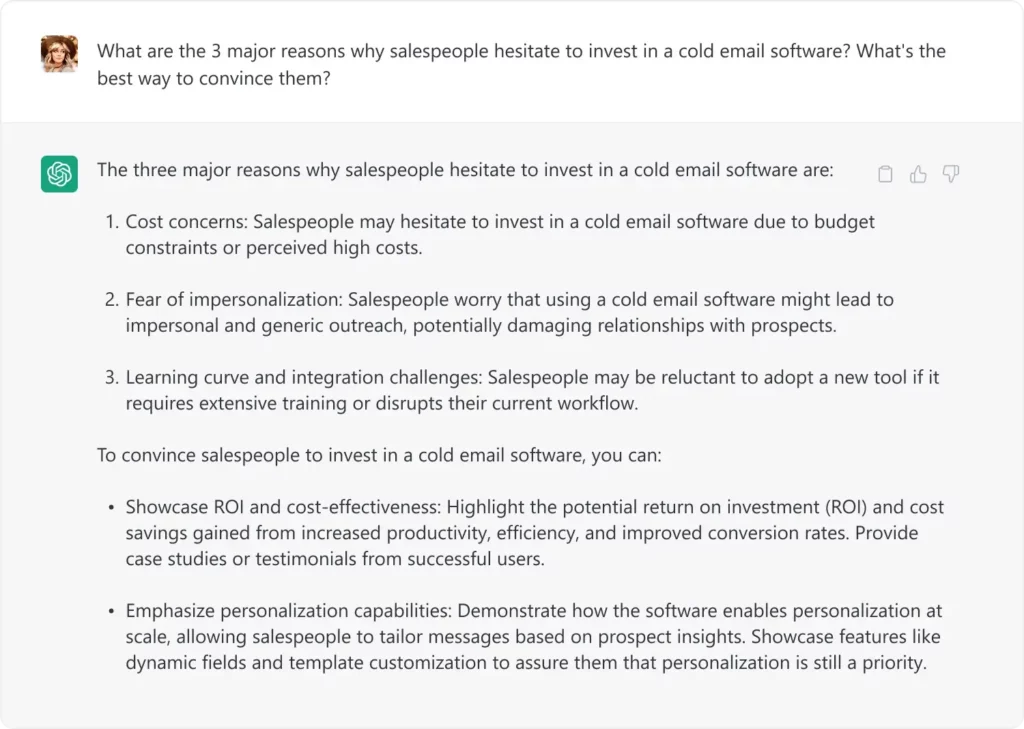
2. ChatGPT Prompts to Create Catchy Email Subject Lines
Prompt 9: Give 5 variations of subject line for a cold email sent to {target audience} who is struggling to streamline his {process}. The subject line should urge them to open the email and create FOMO.

Prompt 10:Craft a pain point driven subject line about the need to automate {process}.

3. Prompts to Write an Introduction for Your Cold Email
Prompt 11: Write a cold email introduction in less than 2 lines comparing {prospect’s interests} and {the pain point you are solving}.
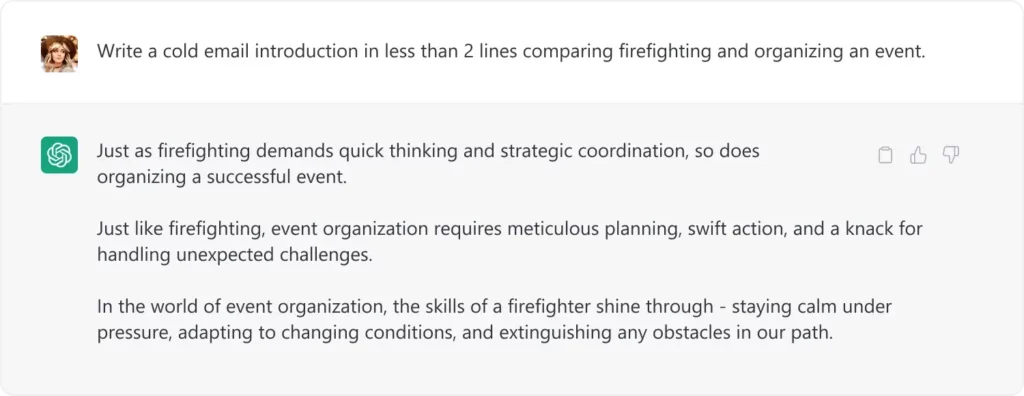
Prompt 12: Write a funny cold email introduction to be sent to {target audience} who is finding it hard to do {task} manually.
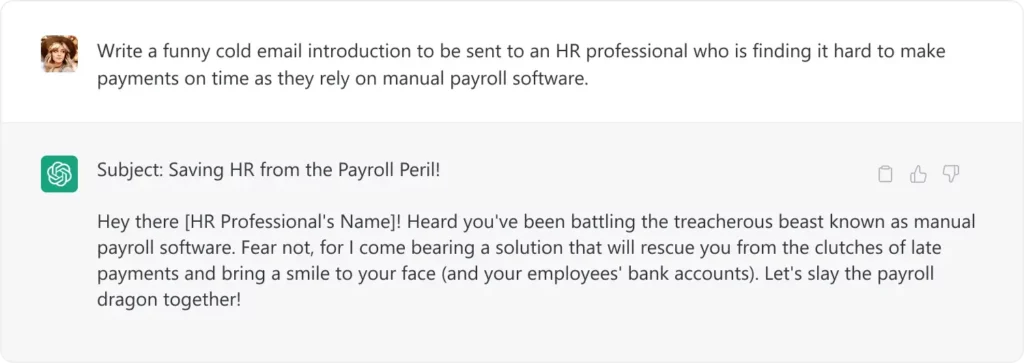
4. Prompts to Craft Compelling CTAs
Prompt 13: Write 3 CTAs urging people to book a meeting with you so that they can scale their {process} without compromising on {something crucial for the success of process}.
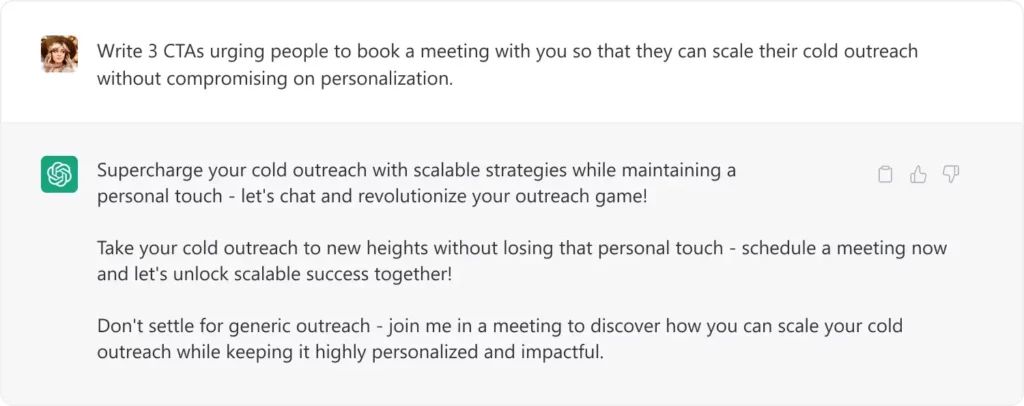
Prompt 14: Write 3 CTAs to create FOMO in readers about not availing the free trial of {app}.
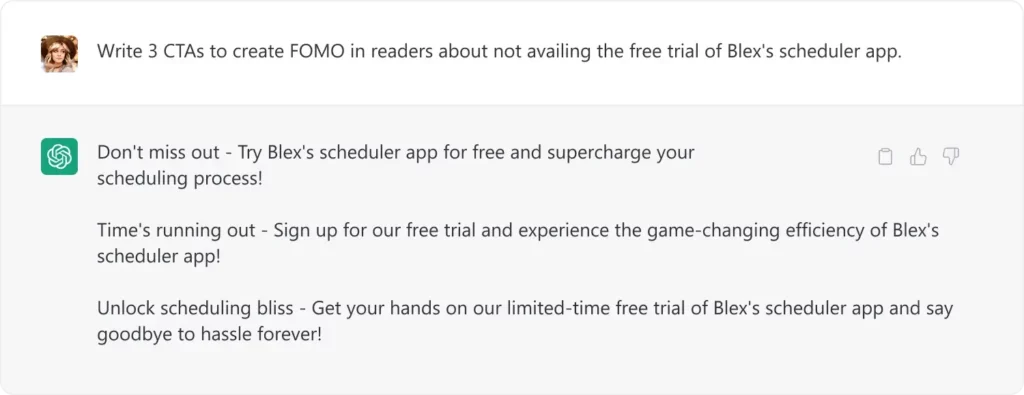
Limitations of Using ChatGPT to Write Sales Emails
Salespeople spend 21% of their time writing emails. That’s around 9 hours per week. With ChatGPT by your side, you can reduce the hours you spend crafting emails. It crafts emails for you in the blink of an eye.
But are they good enough to coax a reply out of your prospects? Short answer, no. Here's why:
The adage “As you sow, so shall you reap” has never been more true. Your results from ChatGPT are solely based on the prompts you give. That means feeding generic prompts gives you boilerplate results, further jeopardizing your chance to stand out in your prospects' inboxes.
One way to avoid generic results is to use specific and detailed prompts. But even with specific prompts, the emails ChatGPT generates require a lot of revisions. Even the most coherent emails by ChatGPT have surface-level personalization and fail to strike the right tone.
This only points in one direction: ChatGPT’s inability to fully grasp your value proposition, your target audience's needs and wants, and your business goals. In other words, even when you feed specific prompts, ChatGPT fails to generate emails that make your target audience tick.
Another issue is with its scalability. As a salesperson sending 100s of emails daily, it isn’t possible for you to use ChatGPT to generate tailored emails for each prospect. Doing that would eat up whatever little amount of time (or even more) you saved by automating the writing process.
But there’s a solution to this.
How to Write Sales Emails at Scale Using ChatGPT in Klenty?
Using Klenty’s AI Cadences.
Klenty’s AI cadence provides sales sequences for over 10+ plus use cases and allows you to tailor it to your needs through prompts. And the best part, you can do all this in under 2 minutes!
Once you choose the best-suited cadence for your use case, AI Cadences identify your company details, like your value proposition and the pain points you solve, and craft emails based on them. It allows you to tweak your emails through prompts and even grades them to ensure your emails are safe from spam filters.
In a Nutshell
ChatGPT is not yet ready to be the writing software that crafts perfect ready-to-go emails that stand out in your prospect’s inbox.
In fact, it is a great starting point to get past the initial inertia salespeople face while crafting emails. It gets the ball rolling by giving a rough first draft that you can tweak to suit your requirements better. But you can still make it work with minimal supervision by using a ChatGPT-assisted sales engagement tool like Klenty.
FAQs
What is ChatGPT?
What Are the Benefits of Using ChatGPT To Write Cold Emails?
1. Generate a rough draft of emails in seconds: ChatGPT lets you skip the inertia when it comes to writing cold emails. It gives you a first draft that you can tweak to your needs.
2. Multiple email variations to choose from : You can prompt ChatGPT to give multiple variations of the same email. This way you can either take the best of these variations or plug and play with different email components.
3. Get unique and catchy openers for your emails: Salespeople spend hours trying to find the perfect email openers. With specific and detailed prompts, you can get pattern-interrupting email openers to gain your prospect’s attention.

